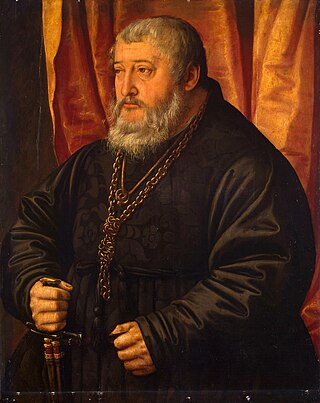
The Electoral Palatinate or the Palatinate, officially the Electorate of the Palatinate, was a constituent state of the Holy Roman Empire. The electorate had its origins under the rulership of the Counts Palatine of Lotharingia in 915; it was then restructured under the Counts Palatine of the Rhine in 1085. From 1214 until the Electoral Palatinate was merged into the Kingdom of Bavaria in 1805, the House of Wittelsbach provided the Counts Palatine or Electors. These counts palatine of the Rhine would serve as prince-electors from "time immemorial", and were noted as such in a papal letter of 1261; they were confirmed as electors by the Golden Bull of 1356.

The House of Wittelsbach is a former Bavarian dynasty, with branches that have ruled over territories including the Electorate of Bavaria, the Electoral Palatinate, the Electorate of Cologne, Holland, Zeeland, Sweden, Denmark, Norway, Hungary, Bohemia, and Greece. Their ancestral lands of Bavaria and the Palatinate were prince-electorates, and the family had three of its members elected emperors and kings of the Holy Roman Empire. They ruled over the Kingdom of Bavaria which was created in 1805 and continued to exist until 1918.

The Palatinate, or the Rhenish Palatinate (Rheinpfalz), is a historical region of Germany. Prior to World War II, it was also referred to as Rhenish Bavaria; as a state of the Holy Roman Empire, it was known as the Lower Palatinate (Unterpfalz), which designated only the western part of the Electorate of the Palatinate, as opposed to the Upper Palatinate (Oberpfalz). It occupies roughly the southernmost quarter of the German federal state of Rhineland-Palatinate (Rheinland-Pfalz), covering an area of 2,105 square miles (5,450 km2) with about 1.4 million inhabitants. Its residents are known as Palatines (Pfälzer).

Swabia is one of the seven administrative regions of Bavaria, Germany. It consists of ten districts and 340 municipalities.

Upper Bavaria is one of the seven administrative districts of Bavaria, Germany.

The Upper Palatinate is an administrative district in the east of Bavaria, Germany. It consists of seven districts and 226 municipalities, including three cities.
Donau-Ries (Danube-Ries) is a Landkreis (district) in Swabia, Bavaria, Germany. It is bounded by the districts of Ansbach, Weißenburg-Gunzenhausen, Eichstätt, Neuburg-Schrobenhausen, Aichach-Friedberg, Augsburg and Dillingen, and by the state of Baden-Württemberg.
Eichstätt is a Landkreis (district) in Bavaria, Germany. It is bounded by the districts of Neuburg-Schrobenhausen, Donau-Ries, Weißenburg-Gunzenhausen, Roth, Neumarkt, Kelheim and Pfaffenhofen, and by the city of Ingolstadt.

Flossenbürg is a municipality in the district of Neustadt an der Waldnaab in Bavaria in Germany. The state-approved leisure area is located in the Bavarian Forest and borders Bohemia in the east. During World War II, the Flossenbürg concentration camp was located here.
Neuburg-Schrobenhausen is a Landkreis (district) in Bavaria, Germany. It is bounded by the districts of Pfaffenhofen, Aichach-Friedberg, Donau-Ries and Eichstätt, and by the city of Ingolstadt.

Wachenheim an der Weinstraße is a small town in the Bad Dürkheim district in Rhineland-Palatinate, Germany, roughly 1 km south of Bad Dürkheim and 20 km west of Ludwigshafen. It is known above all else for its various businesses in the field of winegrowing, and in particular for Sekt.

Palatinate-Neuburg was a territory of the Holy Roman Empire, founded in 1505 by a branch of the House of Wittelsbach. Its capital was Neuburg an der Donau. Its area was about 2,750 km², with a population of some 100,000.

Monheim is a town in the Donau-Ries district, in Bavaria, Germany. It is situated 15 km northeast of Donauwörth, and 27 km east of Nördlingen. It lies in the Regierungsbezirk Schwaben.

Otto-Henry, Elector Palatine, a member of the Wittelsbach dynasty was Count Palatine of Palatinate-Neuburg from 1505 to 1557 and prince elector of the Palatinate from 1556 to 1559. He was a son of Rupert, Count Palatine, third son of Philip, Elector Palatine; and of Elizabeth of Bavaria-Landshut, daughter of George of Bavaria.

The War of the Succession of Landshut resulted from a dispute between the duchies of Bavaria-Munich and Bavaria-Landshut (Bayern-Landshut). An earlier agreement between the different Wittelsbach lines, the Treaty of Pavia (1329), concerned the law of succession and stated that if one branch should become extinct in the male line then the other would inherit. This agreement disregarded imperial law, which stipulated that the Holy Roman emperor should inherit should a line fail.

Höchstädt an der Donau is a town in the district of Dillingen, Bavaria, Germany. It is situated near the banks of the Danube. It consists of the following suburbs: Höchstädt an der Donau, Deisenhofen, Oberglauheim, Schwennenbach and Sonderheim. The town is the seat of the municipal association Höchstädt an der Donau, which includes the towns Blindheim, Finningen, Lutzingen and Schwenningen.

The Neuburg Castle is a palace in Neuburg an der Donau, Upper Bavaria.

The Palatine Lion, less commonly the Palatinate Lion, is an heraldic charge. It was originally part of the family coat of arms of the House of Wittelsbach and is found today on many coats of arms of municipalities, counties and regions in South Germany and the Austrian Innviertel.

The Oberdonaukreis was one of the 15 administrative districts of the Kingdom of Bavaria between 1806 and 1837 named after its main river Danube. It was the predecessor of the Regierungsbezirk Schwaben.






















